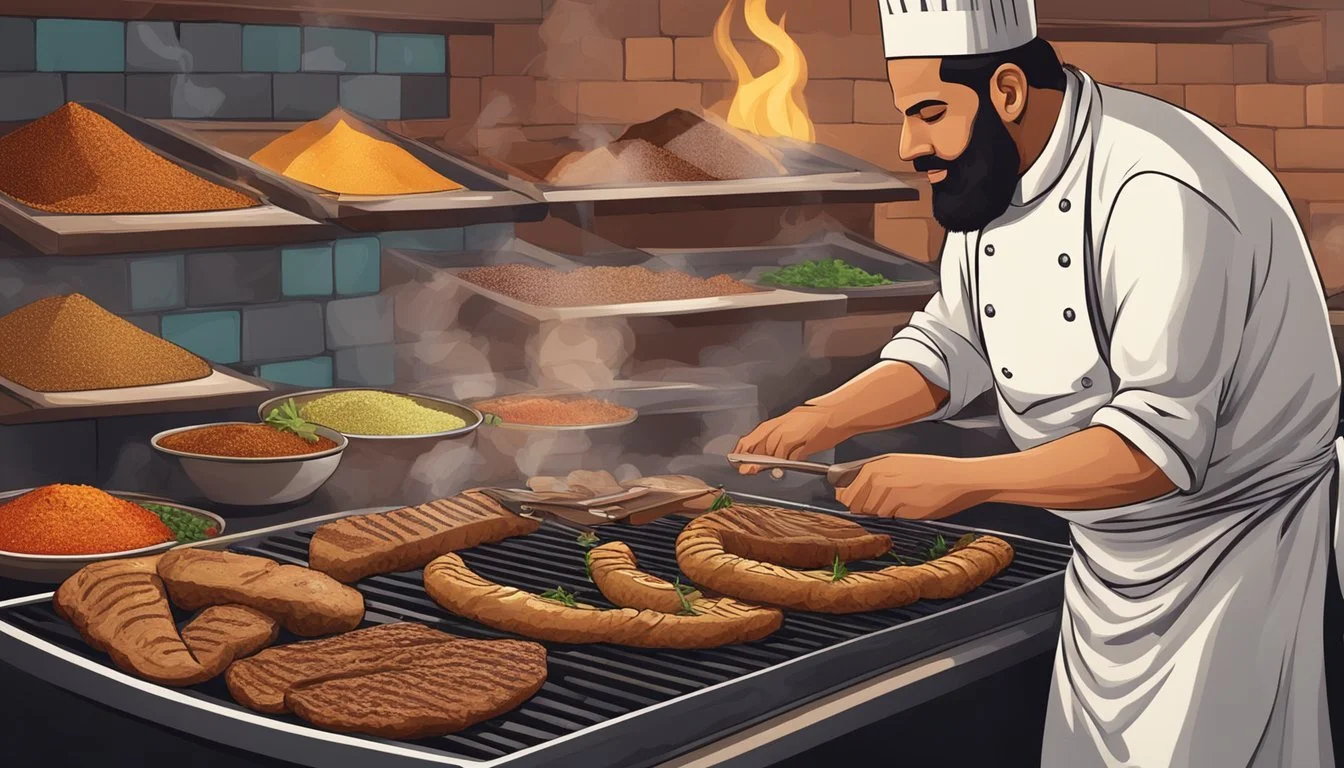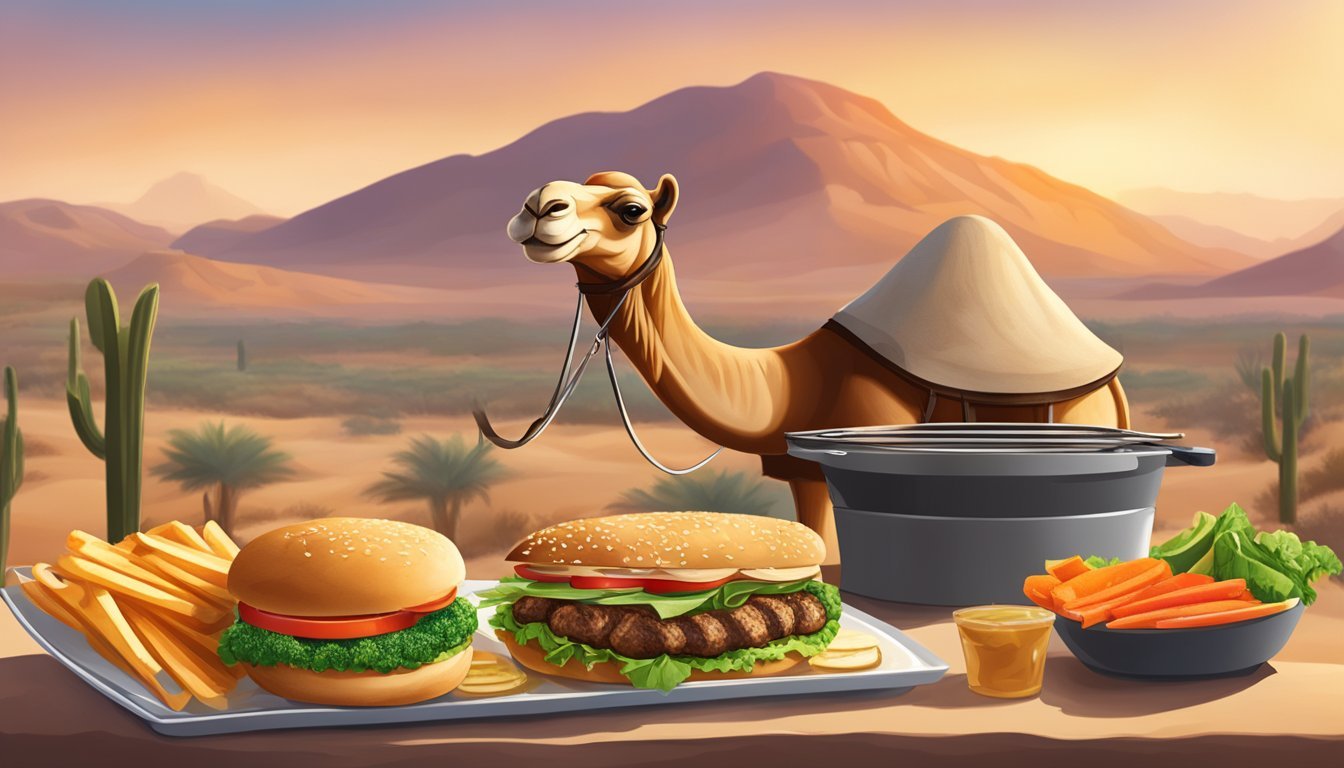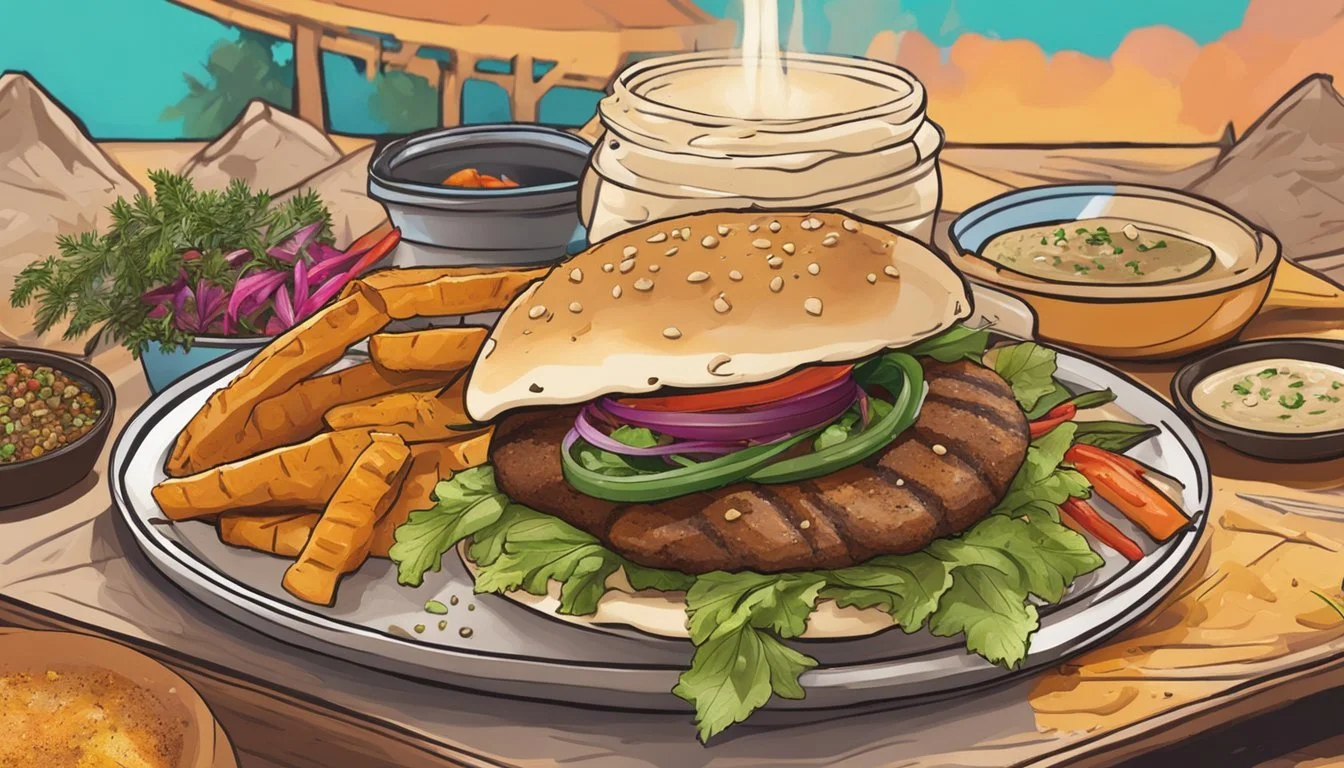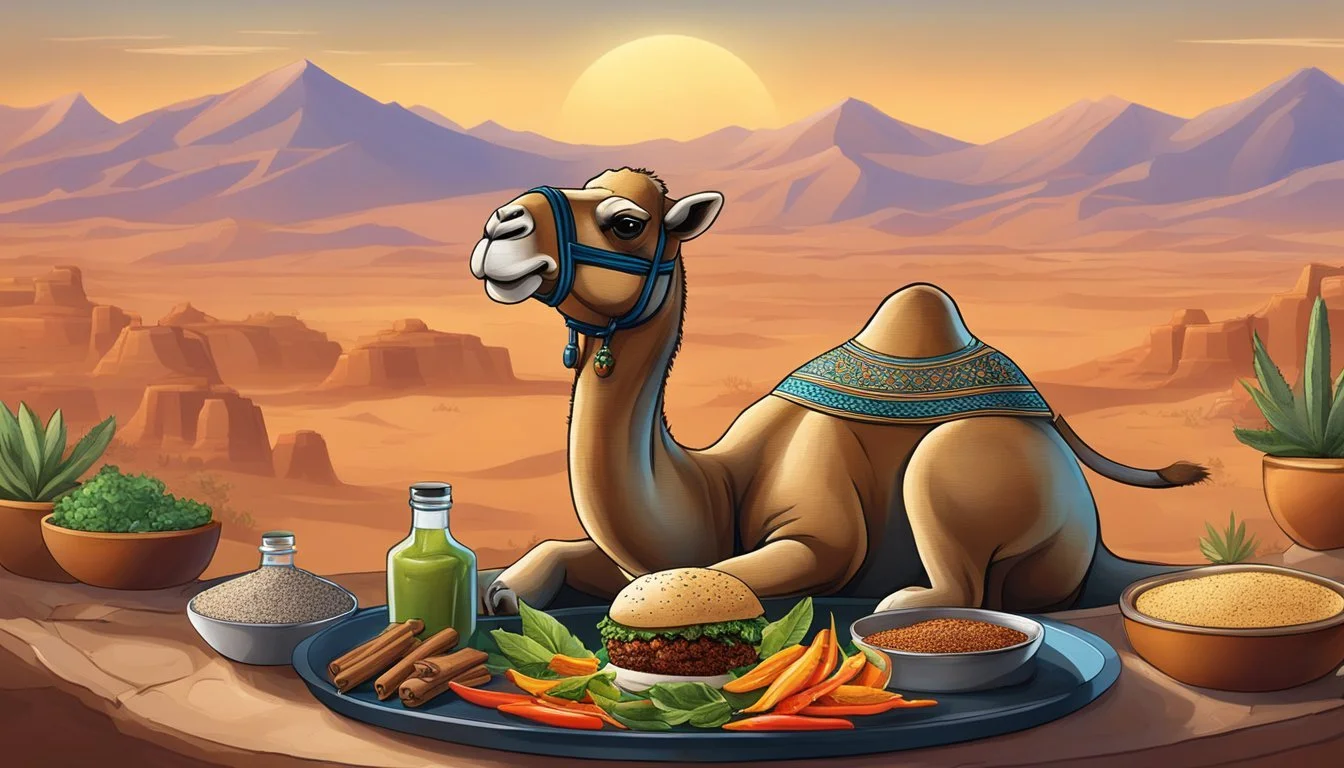Camel Burger Craze
Exploring the Middle Eastern Fast Food Phenomenon
Camel burgers are emerging as an exotic fast food alternative that's capturing the curiosity and taste buds of diners looking for something beyond the conventional beef and chicken options. With its origins steeped in Middle Eastern culinary traditions, the camel burger presents a novel indulgence that combines the heritage of desert nomads with the global trend toward diverse and unconventional eating experiences. Known for its leaner profile and rich, distinctive taste, camel meat transforms the familiar concept of a burger into an intriguing fusion of culture and flavor.
In Middle Eastern countries, where the camel has long been esteemed for its versatility and resilience, the camel burger has been popularized as a contemporary twist on a food source with ancient ties to the region. This 21st century adaptation of camel meat into a fast food staple is not just a nod to the past but also a forward-looking approach to dietary choices. Nutritionally, camel meat boasts higher iron and vitamin C content compared to beef and lamb, aligning with a growing consumer interest in healthier alternatives.
The increasing appeal of camel burgers extends beyond the borders of the Middle East, captivating palates from North Africa to parts of Europe and even making inroads into Australian and North American markets. While still a novelty in many areas, and perceived as a pricier menu item due to the cost of importing camel meat, the dish resonates with adventurous eaters and those seeking to engage with the flavors and cooking methods of different cultures, all wrapped up in the familiar form of a burger.
Camel Burger Basics
In exploring camel burgers, one discovers a unique fast food option with a healthier profile compared to traditional beef. Originating from the Middle East, camel burgers offer a novel culinary experience.
What is a Camel Burger?
A camel burger is a dish made from ground camel meat, often seasoned and served in the same style as a traditional beef burger. The meat is sourced from camels, which are prevalent in Middle Eastern and African countries. A typical camel burger may include spices and is usually paired with standard burger toppings such as lettuce, tomato, and cheese.
Nutritional Comparison to Beef
Comparing the nutritional profile of camel meat to beef reveals differences worthy of consideration:
Fat Content: Camel Meat - Lower, Beef - Higher
Cholesterol: Camel Meat - Lower, Beef - Higher
Lean Protein: Camel Meat - Higher, Beef - Lower
Iron Content: Camel Meat - Comparable, Beef - Comparable
Camel meat is leaner than beef, containing less fat and typically lower levels of cholesterol, making it a potential healthier alternative for those looking to reduce fat intake in their diet. Additionally, it boasts a high iron content similar to that of beef.
Camel Meat Preparation
Preparing camel meat, an ingredient well-regarded in Middle Eastern cuisine, involves careful consideration towards enhancing its tenderness and applying suitable cooking techniques to bring out its distinct taste.
Tenderness of Camel Meat
Camel meat can range from tender to somewhat tough, depending on the cut and the age of the camel. To ensure tenderness, chefs often use specific parts of the camel, such as the hump, which contains more fat, for a naturally tender outcome. For potentially tougher cuts, it is common to employ tenderizing methods like marinating or slow cooking to break down the tougher muscle fibers. The goal is to alleviate any gamey texture and to prevent the meat from becoming dry, especially when preparing dishes like camel steaks or camel kebabs.
Cooking Techniques
For cooking, two popular techniques are grilling and slow-roasting. Grilling over a medium-high flame is ideal for camel burgers or steaks, as it sears the outside, trapping the juices inside, which results in a juicy and flavorful meat. Camel meat, being lean, benefits from careful attention to prevent overcooking. When preparing kebabs, it's imperative to monitor the meat closely to ensure it remains succulent and does not dry out. Slow-roasting, on the other hand, is excellent for less tender cuts, as the prolonged, gentle heat renders the meat fork-tender while infusing the flavors of herbs and spices used in marination.
Culinary Variations
Camel burgers represent a unique culinary adaptation of traditional meats, as chefs and food enthusiasts explore creative ways to incorporate camel meat into modern dining. This section delves into the diverse recipes and dishes that highlight the versatility of camel meat in various culinary traditions.
Camel Burger Recipes
Camel meat forms the foundation for an array of burger recipes that infuse Middle Eastern flavors with a modern twist.
Classic Camel Burger: Ground camel meat seasoned with a blend of cumin, coriander, paprika, salt, and pepper. Served on a toasted bun with optional toppings like hummus, feta cheese, or a yogurt-based sauce.
Spice-infused Camel Burger: Enhanced with Middle Eastern spices such as za'atar and harissa paste, adding depth and heat to the patty.
Camel Meat Dishes
Aside from burgers, camel meat is a staple in several traditional and contemporary dishes.
Camel Biryani: Aromatic rice dish cooked with tender chunks of camel meat, saffron, and a medley of spices, often garnished with fried onions, raisins, and nuts.
Camel Milkshake: A dessert beverage made with camel milk, offering a richer and slightly saltier flavor compared to cow milk. It can be flavored with dates, cardamom, or vanilla.
Camel Salad: Chopped grilled or roasted camel meat tossed with fresh greens, vegetables, and a dressing, creating a hearty and nutritious option.
Traditional Nomad Recipes: Generations of nomads have perfected recipes such as slow-cooked stews and soups, which often include camel meat due to its availability and nutritional value.
Camel Soup: A hearty and nourishing dish prepared with camel meat, vegetables, and spices, simmered to create a warm and comforting meal.
Cultural Significance
The Camel Burger emerges as a contemporary representation of traditional Middle Eastern gastronomy, melding centuries-old customs with modern culinary trends.
Camel Meat in Middle Eastern Cuisine
Camel meat has a deep-rooted history in Middle Eastern cuisine, where it's often seen as a staple source of nourishment. In the arid regions of the Arabian Peninsula, the Bedouins, known for their nomadic lifestyle, have historically relied on camels for a range of uses, including their meat. Camel meat is appreciated for its nutritional value and its role in social and ceremonial occasions. It is also deemed a delicacy in some Middle Eastern cultures due to its rich flavors and perceived health benefits.
Key Facts:
Region: Arabian Peninsula
Cultural Role: Nutritional staple, ceremonial food, Bedouin delicacy
Flavor Profile: Rich, often described as a cross between beef and lamb
Global Camel Meat Consumption
While camel meat is a significant part of diets across the Middle East and parts of Africa, its consumption is not widespread globally. The Food and Agriculture Organization (FAO) recognizes camel meat as a minor yet important animal protein source, mainly in arid regions where camels thrive. Outside the Middle East and Africa, camel meat is still a novelty. However, countries like Australia have entered the market, primarily exporting camel meat to meet the demand in Middle Eastern countries.
Global Perspective:
Primary Consumers: Middle East, Africa
Global Market: Limited, with Australia as a notable exporter
FAO View: Recognized as important for arid regions
Camel Dairy Products
In addition to their role in culinary delicacies like camel burgers, camels also provide a variety of nutrient-rich dairy products, most notably camel milk and unique cheese varieties. These products offer alternative nutritional benefits and cater to various dietary preferences.
Camel Milk
Camel milk is prized for its nutritional profile, rich in vitamins and minerals, particularly vitamin C and iron. Unlike cow's milk, camel milk contains insulin-rich properties, making it a promising option for people with diabetes. It offers a lower fat content and is a valuable source of proteins and unsaturated fatty acids. Consumers can enjoy it fresh, or it can be processed into other dairy items.
Cheese Varieties
Halloumi Cheese: Traditionally made from a mixture of goat's and sheep's milk, halloumi is also produced using camel milk. This semi-hard, unripened, and brined cheese is known for its high melting point, making it an excellent choice for grilling or frying.
Cheddar Cheese: While not traditional, some cheese producers have begun creating cheddar cheese from camel milk. When made from camel milk, this cheddar is distinctive, offering a different take on the typically cow's milk-based cheese.
Please note that the availability of these cheeses may vary by region, and some may be more experimental than mainstream.
Restaurants and Dining Experience
Exploring camel burgers offers a unique culinary adventure that merges traditional fast food concepts with exotic flavors. Restaurants specializing in these burgers have curated experiences that cater to both locals and travelers seeking an authentic taste of the Middle East.
Camel Burger Restaurants
Cafe Clock has positioned itself as a must-visit destination. With locations in Marrakesh, situated at the 224 Derb Chtouka Kasbah area, and Chefchaouen at Derb Tijani in the Hay Souk area, the restaurant has gained fame for its camel burger—a delicacy that has piqued global interest. Patrons can enjoy their meals in a vibrant setting that often features live music sessions, adding an extra layer of cultural immersion to the dining experience.
In Dubai, the Local House Restaurant stands out as a pioneer in serving camel burgers. Located at House No. 51 in Al Bastakiya, near Al Fahidi Round About, the restaurant invites diners to experience the blended taste of fast food and Middle Eastern cuisine in a setting that reflects the heritage of its location.
Dining Beyond the Burger
The camel burger experience extends beyond the patty to encompass a full dining atmosphere. The Mirabel Restaurant in Abu Dhabi, known for its art deco ambiance, elegantly integrates gourmet burger offerings, including camel, into a sophisticated dining setting. It's the synthesis of a '20s-inspired environment with modern culinary practices.
Similarly, Emirates Palace in Abu Dhabi plans to elevate the camel burger by including it in various dining options across the hotel—spanning from the lobby to room service. This initiative allows diners to savor this specialty within the grandeur of one of the city's most prestigious venues, whether on a terrace for dinner or as part of a luxury dining experience at Mezlai restaurant.
Camel Burger as a Modern Phenomenon
Camel burgers have transformed from a traditional dish to a modern culinary trend, attracting both locals and tourists alike, and have made a notable impact on social media platforms.
The Rise of Camel Burgers
Camel meat, once a staple of Bedouin diets, has found its way into the fast food industry as a novel offering. This 21st-century twist has tourists putting camel burgers on their bucket list when visiting the Middle East, eager to experience a unique part of the region's culinary heritage. Sheikh Mohammed bin Rashid Al Maktoum, the ruler of Dubai, underscored the importance of innovation and preserving Emirati culture, of which the camel burger is a flavorful example. In the shadows of the Burj Khalifa, visitors can indulge in this unusual delight at various eateries, including food joints that serve camel burgers created with locally sourced meat.
Camel Burgers on Social Media
The growing popularity of camel burgers is partly fueled by their presence on social media. Platforms like Instagram and Twitter have become a showcase for these exotic treats, with users posting vibrant images and enthusiastic reviews of their camel burger experiences. The unique aesthetic of a camel burger, often accompanied by the luxurious backdrop of Dubai's landmarks like Al Nassma or the expansive desert, captures the interest of food enthusiasts and travelers seeking to document their gastronomic adventures. The effective use of hashtags such as #CamelBurger and #ExoticEats has increased their visibility, enticing the curious and the adventurous to seek out this local specialty.
Pairings and Accompaniments
Camel burgers offer a unique taste experience, and selecting the right side dishes and toppings enhances their flavor. It’s important to consider how each accompaniment compliments the distinctive taste of camel meat.
Side Dishes
Fries: A classic side, fries serve as the perfect companion to camel burgers. Whether one opts for thin, crispy ones or thick-cut steak fries, they provide a satisfying crunch.
Salads: For a lighter option, a fresh salad with crisp vegetables balances the richness of the burger.
Sauces and Toppings
Cheese: A slice of melted cheddar cheese draped over the hot patty adds a creamy texture and sharp taste.
Camel Milkshake: Beverage-wise, a camel milkshake could provide a novel pairing, offering a creamy complement that's surprising yet fitting.
Burger Sauce: Custom-made burger sauces, especially those with a hint of spice, elevate the camel burger without overpowering its natural flavors.
Taza Ketchup: A dollop of Taza ketchup, known for its fresh and tangy profile, can add a familiar yet distinct touch to each bite.
By thoughtfully pairing camel burgers with the right sides and toppings, one can create a meal that's both traditional and innovative.
Expanding the Culinary Experience
The introduction of camel burgers is more than a new menu item; it represents the confluence of culinary adventure and cultural exchange. This expansion in dining options is not only about savoring unique flavors but also engaging with the local customs and innovative cooking techniques.
Interactive Eating Experiences
Camel burgers in Dubai provide customers with interactive eating experiences, such as cooking classes and storytelling sessions. Venues like Camel Corner offer the opportunity for diners to not only taste the tender patties but to also learn about the art of crafting them. Cooking classes may cover seasoning techniques, incorporating spices like paprika and cumin that are essential to creating the rich taste camel meat is known for.
Storytelling: Alongside the sizzle of the grill, patrons can immerse themselves in the tales of Dubai's history and culinary tradition, weaving a narrative that enriches the experience of each bite.
Jam Sessions: Some eateries turn the dining event into an interactive cultural hub, where food and art intersect, allowing for moments of musical expression to accompany the meal.
Fusion Cuisine and Innovation
Camel burgers symbolize the innovative spirit of Dubai's fast food scene by merging tradition with contemporary tastes. Chefs experiment with flavor profiles, creating fusion cuisine that matches the lean camel meat with a variety of ingredients to surprise the palate.
Spice Blends: Bold use of local spices forges a connection between traditional Middle Eastern flavors and modern culinary practices.
Global Influence: Dishes may introduce international sauces or toppings, bridging tastes from across the world into a singular, innovative creation.
Each twist on the camel burger illustrates Dubai's evolving food landscape, embracing both its heritage and the global influence that shapes its present and future dining experiences.
Sustainability and Ethical Considerations
As consumers increasingly seek sustainable and ethically sourced foods, the production of camel burgers merits a closer examination under these criteria.
Environmental Impact
Camel meat stands out for its lower intramuscular fat content and higher iron levels, which contributes to its reputation as a healthier alternative to conventional red meats. Camels are highly adapted to arid environments, requiring less water than other livestock, which positions camel meat as a more environmentally sustainable option. The Food and Agriculture Organization recognizes camels' ability to withstand extreme conditions, suggesting that camels could play a role in food security within desert and drought-prone regions.
Water Usage: Given their adaptation to desert life, camels have a low water footprint compared to other livestock.
Grazing patterns: Camels' natural foraging behavior reduces the need for resource-intensive feed.
Animal Welfare
Camel burgers, by virtue of using camel meat, intrinsically bring up animal welfare considerations. While camels are hardy animals capable of enduring harsh climates, ethical concerns arise regarding their treatment during farming and slaughtering. The meat's gamey taste and the use of hump fat imply specific butchery practices that should be managed humanely. As camel meat is not produced on a mass scale comparable to beef or poultry, there is an opportunity for more individual attention to welfare in camel farming.
Living Conditions: Camels generally require less intensive farming conditions.
Slaughter Techniques: Ethical practices must be adhered to, respecting both animal welfare standards and local traditions.
Finding Camel Burgers
Camel burgers, a distinctive fast food item, are sought after for their unique taste and cultural significance. They are particularly rooted in the Middle Eastern culinary traditions.
Camel Burgers in the Middle East
In the Middle East, camel meat is a traditional ingredient known for its lean and savory qualities. While restaurants offering camel burgers can be found throughout the region, they are more prevalent in certain areas. For instance, Dubai is known for embracing the delicacy in various eateries, incorporating contemporary culinary trends with this traditional meat. Major cities often feature camel burgers in their menus, highlighting the incorporation of local spices and cooking styles. The United Arab Emirates (UAE), with its vibrant food scene, has witnessed an increase in the popularity of camel burgers, especially among tourists looking to experience local flavors.
Marrakesh, Morocco, offers a unique take on camel burgers. Street food staples in the city's historical medina, especially around the Kasbah, provide an authentic taste experience, combining the rich flavors of Moroccan spices with this unconventional meat.
Camel Burger Availability Worldwide
Outside the Middle East, camel burgers are a novelty and are not as commonly available. However, a growing interest in exotic and sustainable meats has seen camel meat emerge in various forms, including burgers, in niche markets around the world.
Australia has developed a market for camel meat due to its rising camel population. Camel meat can be found in specialty butchers and is occasionally featured in local restaurants aiming to present alternative and sustainable cuisine.
In cities with a cosmopolitan population and diverse culinary scene, such as Fez in Morocco, camel burgers can sometimes be found, offering a taste of Middle Eastern cuisine to an international audience.
For those interested in trying camel burgers, one's best chance outside of the Middle East is to order online, despite the higher costs due to import and shipping fees. Some online stores may offer camel meat, providing an opportunity for enthusiasts to cook their own camel burgers at home.
Camel Corner and similar establishments have recognized the potential of camel meat and have started to distribute camel burger patties, although they may not be widely available in mainstream supermarkets like Walmart or Costco.
Camel Burger in Popular Culture
Camel burgers, a novelty item in Middle Eastern fast food, have found a place in popular culture, largely due to their unique gamey taste and ties to traditional Arab cuisine.
Media and Literature
In media, camel burgers are occasionally referenced as an exotic delicacy that surprises the palate with its distinctive flavor that is less pervasive than camel steak but more pronounced than standard beef. Although they haven't featured prominently in mainstream literature, travelogues and culinary articles often mention camel burgers in passing, highlighting their role in Arabian Peninsula gastronomy as a bridge between old and new.
Tourism and Camel Burgers as Attraction
Tourists seeking to immerse themselves in local culture frequently encounter camel burgers as part of their culinary journey, especially in Morocco where this dish is woven into the fabric of Moroccan cuisine.
Markets and Street Food: Visitors are drawn to the bustling markets where camel burgers are served freshly grilled, often accompanied by a variety of sides such as tagines or salads.
Restaurants: Establishments across Morocco specialize in camel burgers, making them a go-to spot for tourists who wish to experience authentic local flavors.
Culinary adventurers often note the surprisingly tender texture of camel meat, which is sometimes combined with mushrooms and other local ingredients to enhance its appeal. Camel burgers, by becoming part of tourism offerings, strengthen the ties between the Arabian Peninsula's culinary heritage and the global palate, showcasing the rich tapestry of flavors found in Middle Eastern cuisine.









